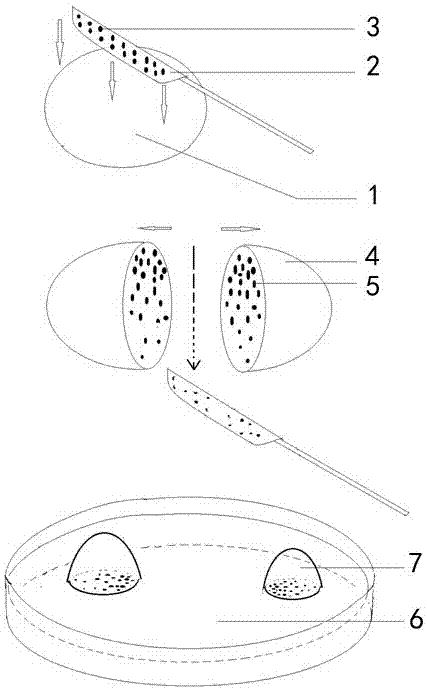A method for Agrobacterium infection during callus transformation of Taxus chinensis
A technology of callus transformation and yew, applied in the field of bioengineering, can solve the problems of low transformation efficiency and survival rate, and achieve the effects of avoiding poisoning, high transgenic efficiency, and wide application value
- Summary
- Abstract
- Description
- Claims
- Application Information
AI Technical Summary
Problems solved by technology
Method used
Image
Examples
Embodiment 1
[0022] Induction and Proliferation of Embryogenic Callus of Taxus chinensis
[0023] 1. Propagation of yew aseptic seedlings
[0024] Peel off the outer skin of the yew seeds, and disinfect the complete endosperm. The procedure is as follows: 75% ethanol for 2 minutes, 0.1% mercuric chloride for 10 minutes, and sterile water for 3 times. Base+6-BA1.0 mg / l+2,4-D 0.1 mg / l+hydrolyzed casein 1.0 g / l+activated carbon 1 g / l+sucrose 20 g / l+phytogel 2.6 g / l ( Among them, the number after the component indicates the addition amount (g) of the component in the unit volume (l) of the B5 medium). First, the seeds are germinated in a dark environment, and then the light is gradually increased, and a weaker slow light is used for cultivation. , the aseptic seedlings of Taxus chinensis can be obtained, and after the seedlings grow to 2-3 cm, the hypocotyls are cut for callus induction.
[0025] 2. Induction of Embryogenic Callus of Taxus chinensis
[0026]The hypocotyls were inoculated o...
Embodiment 2
[0028] Obtaining Plant Expression Vector pCAMBIA1304 Containing GUS Gene in Agrobacterium tumefaciens
[0029] The plant expression vector pCAMBIA1304 was transformed into Agrobacterium tumefaciens (such as EHA105, which is a publicly available biological material in the market and can be purchased from CAMBIA Company in Australia, the strain number is Gambar 1), and PCR verification was performed. Specifically, first prepare competent Agrobacterium tumefaciens (such as EHA105): cultivate Agrobacterium tumefaciens until the bacterial liquid O.D 600 =0.5, put the bacterial solution on ice for 30 minutes, take the bacteria into a 1.5 ml Eppendorf tube, centrifuge at 5000 rpm at 4°C for 5 minutes, remove the supernatant; use 0.1M CaCl sterilized by suction filtration 2 (Pre-cooling) 400 μl of suspended bacteria (mixed gently with a pipette gun), placed on ice for 30 minutes, centrifuged at 5000 rpm for 5 minutes, removed the supernatant, and washed with 100 μl of pre-cooled 0.1M ...
Embodiment 3
[0031] 1. Agrobacterium tumefaciens-mediated transformation
[0032] 1.1. Cultivation of Agrobacterium tumefaciens
[0033] Pick a single colony of Agrobacterium tumefaciens engineering bacteria containing the plant expression vector in the culture medium (it consists of: YEB liquid medium+streptomycin (Str) 25 μg / ml+kanamycin (Kan) 100 μg / ml ml+rifampicin (Rif) 40 μg / ml), shake overnight at 180 rpm on a shaker at 28°C, and when the concentration of the bacterial solution reaches OD the next day 600 = 0.5, centrifuge at 5000 rpm for 10 minutes, pour off the upper culture medium, resuspend the Agrobacterium precipitated at the bottom, add 100 μM acetosyringone, and activate it on a shaker (180rpm) at 28°C for 2 hours before transforming Taxus Embryogenic callus.
[0034] 1.2. Co-culture of Agrobacterium tumefaciens and explants
[0035] Infiltrate the sterile blade with the Agrobacterium tumefaciens bacteria solution, cut the embryogenic callus block of about 1 cubic centim...
PUM
 Login to View More
Login to View More Abstract
Description
Claims
Application Information
 Login to View More
Login to View More - Generate Ideas
- Intellectual Property
- Life Sciences
- Materials
- Tech Scout
- Unparalleled Data Quality
- Higher Quality Content
- 60% Fewer Hallucinations
Browse by: Latest US Patents, China's latest patents, Technical Efficacy Thesaurus, Application Domain, Technology Topic, Popular Technical Reports.
© 2025 PatSnap. All rights reserved.Legal|Privacy policy|Modern Slavery Act Transparency Statement|Sitemap|About US| Contact US: help@patsnap.com

